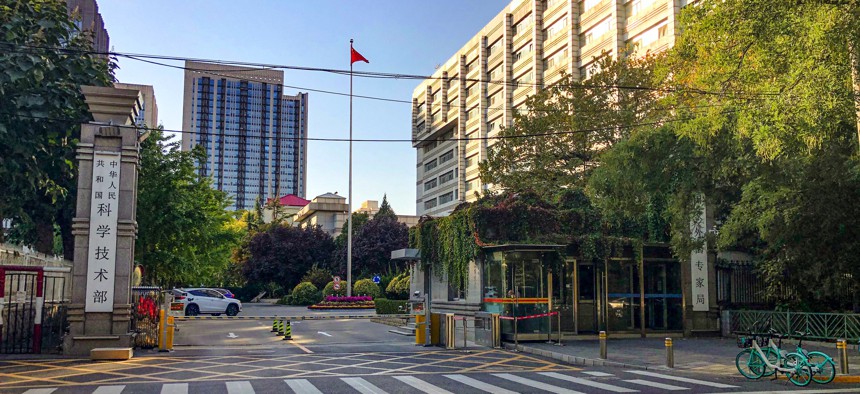
The Ministry of Science and Technology of the People's Republic of China in Beijing. N509FZ via Wikimedia
Mapping China’s Sprawling Efforts to Recruit Scientists
Beijing’s high-profile Thousand Talents Program is a tiny piece of a broad national strategy to build military and economic advantage.
The Thousand Talents Plan is likely the best-known of Beijing’s efforts to lure leading researchers, scientists, and scholars to contribute to China’s strategic goals, primarily as they relate to science and technology. Last year, the Senate’s homeland security committee said the TTP’s drain on U.S.-based talent and intellectual property continues to “endanger our national security.” But Thousand Talents is merely a tiny piece of a larger strategy; an estimated 250-plus such programs comprise a sprawling network that, until now, has not been mapped and made available to the public. If the United States wants to combat China’s talent recruitment efforts, policymakers, academics, journalists, and others must take heed.
The Chinese Talent Program Tracker, a new project by Georgetown University’s Center for Security and Emerging Technology, aims to build a stronger understanding of the depth and breadth of Beijing’s talent recruitment efforts. Users can filter through national-level talent programs by status of program, desired audience, intended sectors, and other characteristics.
In designing the tracker, my CSET colleagues and I decided to include two ways to filter the intended audience: by location (within China or abroad) and by Chinese citizenship requirement. The result identifies three target groups: Chinese citizens in China, the Chinese diaspora living abroad, and foreigners. Since the U.S. Justice Department launched its China Initiative in 2018, individuals from all three of these target groups have been charged with participating in a wide array of Chinese talent programs beyond Thousand Talents.
One of the most notable discoveries in building this tracker was the need to differentiate between “foreign” and “overseas” in the context of Chinese talent programs, as “overseas” often refers to the Chinese diaspora, as opposed to “foreign,” which refers to non-Chinese citizens. The Chinese language even has terms like huaqiao that refers to overseas Chinese, and haigui that refers to someone who gains experience abroad and returns to China. These terms, often found right in the name or description of a talent program, can reveal a lot about a program’s intended audience.
Additionally, the Chinese Talent Program Tracker includes information about residency requirements—either part-time or full-time—for talent program participants. In response to failed attempts at combatting a “brain drain,” Chinese leadership have begun to tout a policy of “serving the nation from abroad,” which aims to target individuals in strategic positions outside China who can transfer technology and IP from overseas. This has lessened the need for talent program participants to remain in China. Talent initiatives like the “Spring Light” or “Chunhui” Program allow Chinese Ph.D students and academics to maintain their positions or studies overseas as long as they offer “new information or technology, or transfer information to other overseas scholars or graduate students about conditions in China,” to the benefit of the state.
Chinese talent programs are and will continue to be a moving target. In the past year alone, China has worked to scrub references to Thousand Talents from the internet, likely as the result of increased scrutiny of the program by the U.S. government and others. As helpful as it is to know the ins and outs of individual talent programs, there is arguably more to be said in understanding the depth of and strategy behind these talent initiatives. The Chinese Talent Program Tracker is designed to do just that.
Although it includes specific information for individual programs, our tracker aims to provide a holistic, concise, and digestible assessment of them. It will grow to include provincial and municipal-level programs, as well as those associated with specific universities and organizations, and even talent competitions, as these are all key tenets of Beijing’s innovation strategy. Tracking down the many programs and detailing them in an objective, open platform will allow for greater understanding of this issue and contribute to new and informative policy to combat China’s technology transfer efforts.
It is not lost on U.S. policymakers that scientific and scholarly exchange programs can serve benevolent purposes such as advancing research, increasing international collaboration and improving mutual cultural understanding. Moreover, these exchanges bring real and significant benefits that allow the U.S. to maintain its position as the world’s technology leader. However, getting a handle on the extent to which some of these programs are intended to poach intellectual property is critical to continued U.S. economic health: Chinese theft of IP costs the United States between $225 billion and $600 billion per year, according to a 2018 USTR investigation, and talent programs are key vectors in the Chinese government’s technology transfer scheme.
Emily Weinstein is a Research Analyst at Georgetown’s Center for Security and Emerging Technology (CSET), focused on Chinese innovation and domestic S&T policies and development.



